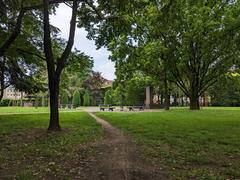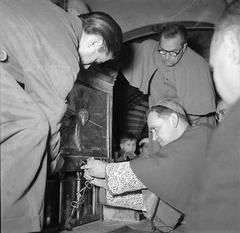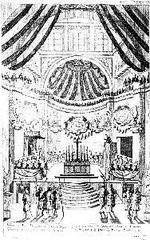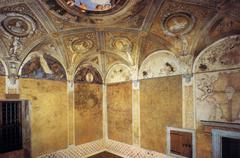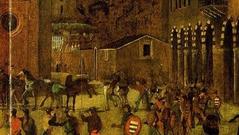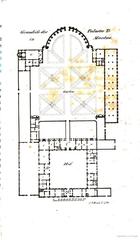San Francesco Mantua: Visiting Hours, Tickets, and Complete Visitor Guide
Date: 15/06/2025
Introduction
San Francesco Church, located in the heart of Mantua, Italy, stands as a remarkable testament to centuries of religious devotion, artistic achievement, and the city’s vibrant cultural heritage. Founded in the early 14th century and consecrated in 1459, San Francesco is renowned for its blend of Romanesque, Gothic, and Renaissance architectural features. The church’s history is deeply intertwined with the influential Gonzaga family, whose patronage transformed Mantua into a Renaissance cultural center. Today, San Francesco invites visitors to experience its preserved frescoes, chapels, and funerary monuments, offering a unique window into the city’s past. Conveniently situated within Mantua’s UNESCO World Heritage-listed center and near major attractions like Palazzo Ducale and Piazza delle Erbe, San Francesco is an essential stop for any traveler.
For the most current updates, consult the Official Mantua Tourism Website, as well as resources like Wikipedia: San Francesco, Mantua and Wild About Travel.
Table of Contents
- Introduction
- Origins and Foundation
- Architectural Evolution
- Cultural and Religious Significance
- Notable Events and Transformations
- Visiting Hours and Tickets
- Travel Tips
- Nearby Attractions
- Accessibility
- Visitor Etiquette
- FAQs
- Visual and Media Recommendations
- Role in Mantua’s Heritage
- Conclusion
- References
Origins and Foundation
San Francesco was established in 1304 during a period marked by Mantua’s growing spiritual and civic prominence. The church’s foundation reflected the Franciscan Order’s ideals of humility, poverty, and service, and coincided with the early rise of the Gonzaga family, who would become pivotal political and cultural leaders in the city (Wikipedia: San Francesco, Mantua). The church was consecrated in 1459 by Pope Pius II, a testament to its significance and the ambitious scale of its construction.
Architectural Evolution
San Francesco’s architecture is an eloquent mix of Romanesque solidity and Gothic verticality, enriched over time with Renaissance elements. The original structure featured robust brickwork and rounded arches, while later renovations introduced pointed arches, ribbed vaults, and elegant chapels. Interior highlights include the Cappella Gonzaga, adorned with restored frescoes by Serafino de’ Serafini, and the once-housed masterpiece “St. Bernardino of Siena between Two Angels” by Andrea Mantegna, now in Milan’s Pinacoteca di Brera. These artistic programs reflect Mantua’s vibrant engagement with broader Italian and European traditions (Travel Connect Experience).
Cultural and Religious Significance
San Francesco has long been a hub for spiritual activity, charity, and education in Mantua. The church’s central location at Piazza San Francesco d’Assisi 5 made it a focal point of the city’s religious life. The Cappella Gonzaga serves as the burial site of several members of the Gonzaga family, highlighting the church’s dual role as both spiritual center and political symbol (Italian Tribune). Artistic commissions within the church served both devotional and commemorative purposes, celebrating the piety and patronage of Mantua’s ruling elite.
Notable Events and Transformations
San Francesco’s history includes periods of both prosperity and adversity. The church was suppressed in 1782 during widespread European reforms, and its treasures were dispersed in the wake of the Napoleonic Wars. In the 19th and 20th centuries, the building was repurposed for military use and suffered damage during World War II. Nonetheless, restoration efforts have preserved significant features, including the Cappella Gonzaga and its frescoes, ensuring the church’s survival as a testament to resilience and cultural memory (Wild About Travel).
Visiting Hours and Tickets
Standard Visiting Hours:
- Tuesday to Sunday: 9:00 AM – 6:00 PM
- Monday: Closed
- Religious Holidays and Special Events: Hours may vary; check the official tourism website for updates.
Admission:
- Entry is typically free of charge (Museionline), though donations are welcome. Special exhibitions or guided tours may have a fee.
Guided Tours:
- Local operators offer guided tours that include San Francesco as part of Mantua city walks. These tours provide context and access to restricted areas. Book through the visitor center or local agencies.
Travel Tips
- Best Times: Mornings and late afternoons are less crowded and offer a tranquil atmosphere.
- Photography: Non-flash photography is generally permitted; avoid taking photos during services.
- Dress Code: Shoulders and knees should be covered; hats removed. Silence and respect are expected, especially during religious functions.
- Combined Visits: Pair your visit with nearby sites like Palazzo Ducale, Rotonda di San Lorenzo, and Piazza delle Erbe for a fuller experience.
- Language: Most signage is in Italian. English is understood to a limited extent; translation apps are useful.
Nearby Attractions
- Palazzo Ducale: Former residence of the Gonzaga family, a Renaissance masterpiece.
- Piazza delle Erbe: Vibrant square with markets and historic buildings.
- Rotonda di San Lorenzo: Mantua’s oldest church, dating to the 11th century.
- Duomo di Mantova: The city’s cathedral, showcasing layers of architectural history (Nomadic Niko).
Accessibility
San Francesco is accessible via the flat, pedestrian-friendly streets of Mantua’s center. The main entrance is wheelchair-friendly, though some historic chapels have uneven flooring. Assistance is available from staff if needed. Restrooms are available in nearby cafés and public spaces.
Parking is available near Piazza Sordello (paid) or at Campo Canoa (free with shuttle and pedestrian bridge) (A Sprinkle of Italy).
Visitor Etiquette
- Maintain silence, especially during services.
- Eating, drinking, and use of mobile phones inside is prohibited.
- Respect areas reserved for worship and avoid entering during Mass unless participating.
- Modest attire is required.
Frequently Asked Questions (FAQ)
Q: What are the San Francesco Mantua visiting hours?
A: Tuesday to Sunday, 9:00 AM – 6:00 PM. Closed Mondays. Check for holiday variations.
Q: Is there an entrance fee?
A: Admission is free; donations are appreciated. Special tours may require a fee.
Q: Are guided tours available?
A: Yes, via local tourism operators and as part of broader city tours.
Q: Is the church accessible for visitors with disabilities?
A: The main entrance is accessible, though some historic areas have uneven floors.
Q: Where can I park?
A: Paid parking is available near Piazza Sordello; free parking at Campo Canoa with shuttle service.
Visual and Media Recommendations
- High-quality images of the church’s façade, interior chapels, and frescoes enhance understanding and engagement. Use descriptive alt text such as “San Francesco Mantua façade” and “Interior frescoes of San Francesco Mantua.”
- Consider virtual tours or mapping tools for orientation (Nomadic Niko).
Role in Mantua’s Heritage
Recognized as part of Mantua’s UNESCO World Heritage listing (The Travel Folk), San Francesco encapsulates the city’s Renaissance identity and enduring spiritual legacy. Its layered history, from medieval origins to Renaissance flourishing and modern restoration, mirrors Mantua’s broader story of resilience, creativity, and cultural stewardship.
Conclusion
San Francesco in Mantua offers a rare and rewarding encounter with the city’s faith, art, and history. With its accessible visiting hours, free entry, and central location, it welcomes everyone from art lovers and history enthusiasts to spiritual seekers and casual travelers. Plan your journey with confidence using this guide, explore nearby attractions, and immerse yourself in Mantua’s timeless charm.
For more travel inspiration and up-to-date visitor information, download the Audiala app and follow related social media channels.
References
- Wikipedia: San Francesco, Mantua
- Wild About Travel
- Travel Connect Experience
- Museionline
- Official Mantua Tourism Website
- The Travel Folk
- Italian Tribune
- Sacred Architecture
- Nomadic Niko
- A Sprinkle of Italy
- Pinacoteca di Brera Museum

